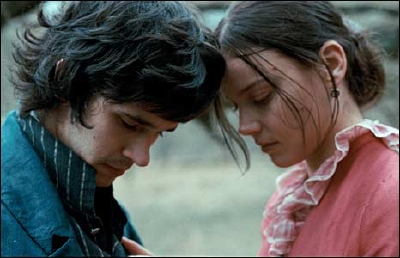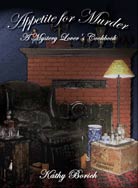Bright Star: Orange and Walnut Crumpet Recipe
Year Released: 2009
Directed by: Jane Campion
Starring: Abbie Cornish, Ben Whishaw, Paul Schneider
(PG, 119 min.)

"A thing of beauty is a joy forever." John Keats
In the dark sky of current movie releases hovers a single Bright Star that is incandescent. This tender love story of romantic poet John Keats and his ladylove is as delicate, ephemeral, and beautiful as the butterflies that flitter across the fields beyond his doorway.
Director Jane Campion, known to create a kind of cinematic poetry in her films, creates a piece of work that is as sensuous and delicately crafted as Keats’ verse. The landscapes outside the Hampstead dwelling Keats (Ben Whishaw) shares with his friend, Charles Brown (Thomas Sangster) look like Monet canvases come to life. The stirring of love is echoed in a dazzling field of blue wildflowers; butterflies float as light as twin souls, while snow covered branches remind us of the cold hand of death.
Fanny Brawne (Abbie Cornish) is the woman/child who is drawn to neighbor John Keats just as he is to her, though it is her point of view that permeates the growing romance. We first see her deft fingers stitching by early morning sunlight, and then view her donning her own creations. Like her they are bold and original.
Chided by Charles Brown as being somewhat vain about her dress, while he and Keats by comparison are engaged in the high art of poetry, she counters that her sewing is at least a source of income, which, unfortunately, the poetic scribbling is not. But she is intrigued with the shy poet Keats, just as she is repelled by his taunting friend, and she sends her brother Samuel to the bookstore to buy Keats’ recent work, the epic Endymion.
“It begins well,” she tells him, her criticism not as scathing as that of his contemporaries, “but after that I am not sure.” If she is uncertain of his pen, Fanny is clearly drawn to the man, taking it upon herself to bake biscuits for the mortally ill brother Keats tends to daily. When she hears of his death, Fanny stays up all night embroidering a silken pillowcase for his final rest.
Many obstacles stand between Keats and Fanny, the first of which is his poverty. As Fanny is told regularly by her widowed mother and caring neighbors, he is not a suitable marital match for her. And then there is Charles Brown, who sees Keats’ infatuation as an unhealthy diversion to his writing. He does everything he can to make Fanny’s every visit to their shared abode as uncomfortable as possible.
But their love endures. He writes her exquisite letters when they are parted for the summer: she smothers her replies in tender kisses, the stationery receiving the passion if he cannot.
Then enters a specter that cannot be ignored. Consumption, that romantic name for what we more clinically call tuberculosis, enters with a fevered cough and hemorrhaging. Having nursed his brother through this, Keats knows this will not end well. The tragic underpinnings make his and Fanny’s love all the more treasured. When he leaves for Italy for its mild climate, she must stay behind. Fanny’s mother now accepts him into the family, saying they can marry when he returns.
As the two nestle next to each other the night before he leaves, they soothe themselves with a fantasy of their future life. Alas, the envisioned bright morning sun outside their home, the shrouded mountains and the flowered fields are no more real than the dreamlike visions of Keats’ beautiful verse.
The once bold and confident Fanny receives news of his death in mute silence, then in gasping sobs that wrench her body and choke off her breath as surely as his has been. It is a scene of elegiac loss that wrenches the audience as well.
That same feeling of loss lingers as the film generates a deeper sadness –that something is missing from our modern world. Keats’ world was filled with restrictions and dread. He saw his brother die a painful death and knew in vivid detail the track his will follow. Social convention kept the two lovers apart, their love forever chaste.
Today, Keats could be cured of his tuberculosis through the miracle of modern medicine. He and Fanny could live together is “conjugal” bliss, whether or not they could afford to marry. Who knows, he might even receive a government grant to fund his writing. But at what price? Ours is an external world of sensation and often soulless pleasure. We attach ourselves to an electric social grid that lulls us to a stupor of numbness. Tweets and Twitters come from a mechanical box instead of a bird.
The young people of nineteenth century Hampstead gathered together to sing, dance, or tease a tune out of a violin. Today we live in our insular iPod world, in bubbles of self-imposed isolation. Sated pleasures are never as intense as those out of reach.
In Keats’ short life he experienced an intensity that very few could today. His tragedy was of deprivation; ours is of excess.
—Kathy Borich
Film-Loving Foodie
Keats’ friend Mister Charles Brown is in considerably better humor with his housekeeper than he is with Fanny Brawne. Perhaps it is her warm morning crumpets and homemade jam that lift his spirits.
It is most difficult to be peevish when confronted with warm pastry, don’t you think.
This recipe for Orange and Walnut Crumpets comes from Different Drummer’s own Appetite for Murder: A Mystery Lover’s Cookbook.
You can download a sample from this site. Keep it in mind for a delightful holiday gift, if I do say so myself.
Here are a few other English delicacies to enjoy:
Raspberry Trifle with Sherry Drizzle
Treacle Tart with Custard Sauce
Orange and Walnut Crumpets
Sometimes called piketlets, these griddle-fried cakes are similar to but somewhat softer than “English muffins.”
- 2 cups water and milk, mixed
- 1 tbsp active dry yeast
- 4 1/2 cups bread flour
- 1 tsp salt
- 3 tablespoons grated orange rind
- 1 cup chopped walnuts
Heat the water and milk mixture until just tepid and remove from heat. Dissolve the yeast in a little of the warm liquid. Put the flour and salt into a large bowl, make a well in the center, and pour in the yeast and remaining liquid, mixing well with a wooden spoon. Add the grated rind and chopped walnuts and mix them well, but don't overbeat. Cover the bowls with plastic wrap, and keep in a warm place until the mixture rises.
Heat a lightly greased cast iron griddle and place the greased, metal crumpet or flan rings on top. Tuna cans with tops and bottoms removed are an excellent substitute. Spoon in some of the mixture, to about half way up the rings, and cook until bubbles form on the top, then remove the rings and cook for another couple of minutes, until the underside is lightly browned. Serve with butter and homemade jam.
Recipe Source: Appetite for Murder: A Mystery Lover’s Cookbook



 Rainy Day Rentals
Rainy Day Rentals
